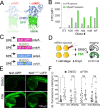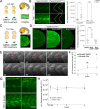A cAMP Sensor Based on Ligand-Dependent Protein Stabilization
- PMID: 35839076
- PMCID: PMC9396618
- DOI: 10.1021/acschembio.2c00333
A cAMP Sensor Based on Ligand-Dependent Protein Stabilization
Erratum in
-
Correction to "A cAMP Sensor Based on Ligand-Dependent Protein Stabilization".ACS Chem Biol. 2024 Apr 19;19(4):1022. doi: 10.1021/acschembio.4c00126. Epub 2024 Mar 8. ACS Chem Biol. 2024. PMID: 38456802 Free PMC article. No abstract available.
Abstract
cAMP is a ubiquitous second messenger with many functions in diverse organisms. Current cAMP sensors, including Föster resonance energy transfer (FRET)-based and single-wavelength-based sensors, allow for real time visualization of this small molecule in cultured cells and in some cases in vivo. Nonetheless the observation of cAMP in living animals is still difficult, typically requiring specialized microscopes and ex vivo tissue processing. Here we used ligand-dependent protein stabilization to create a new cAMP sensor. This sensor allows specific and sensitive detection of cAMP in living zebrafish embryos, which may enable new understanding of the functions of cAMP in living vertebrates.
Conflict of interest statement
The authors declare no competing financial interest.
Figures




Similar articles
-
Transgenic fruit-flies expressing a FRET-based sensor for in vivo imaging of cAMP dynamics.Cell Signal. 2007 Nov;19(11):2296-303. doi: 10.1016/j.cellsig.2007.07.004. Epub 2007 Jul 12. Cell Signal. 2007. PMID: 17689927
-
Review article: cyclic AMP sensors in living cells: what signals can they actually measure?Ann Biomed Eng. 2002 Sep;30(8):1088-99. doi: 10.1114/1.1511242. Ann Biomed Eng. 2002. PMID: 12449769 Review.
-
cAMPr: A single-wavelength fluorescent sensor for cyclic AMP.Sci Signal. 2018 Mar 6;11(520):eaah3738. doi: 10.1126/scisignal.aah3738. Sci Signal. 2018. PMID: 29511120 Free PMC article.
-
Imaging the cAMP-dependent signal transduction pathway.Biochem Soc Trans. 2005 Dec;33(Pt 6):1323-6. doi: 10.1042/BST0331323. Biochem Soc Trans. 2005. PMID: 16246109 Review.
-
Assessment of cAMP-PKA Signaling in Candida glabrata by FRET-Based Biosensors.Methods Mol Biol. 2022;2542:177-191. doi: 10.1007/978-1-0716-2549-1_13. Methods Mol Biol. 2022. PMID: 36008665
Cited by
-
Molecular Spies in Action: Genetically Encoded Fluorescent Biosensors Light up Cellular Signals.Chem Rev. 2024 Nov 27;124(22):12573-12660. doi: 10.1021/acs.chemrev.4c00293. Epub 2024 Nov 13. Chem Rev. 2024. PMID: 39535501 Free PMC article. Review.
-
Enhanced kinase translocation reporters for simultaneous real-time measurement of PKA, ERK, and Ca2.bioRxiv [Preprint]. 2024 Oct 2:2024.09.30.615856. doi: 10.1101/2024.09.30.615856. bioRxiv. 2024. Update in: J Biol Chem. 2025 Mar;301(3):108183. doi: 10.1016/j.jbc.2025.108183. PMID: 39411162 Free PMC article. Updated. Preprint.
-
Enhanced kinase translocation reporters for simultaneous real-time measurement of PKA, ERK, and calcium.J Biol Chem. 2025 Mar;301(3):108183. doi: 10.1016/j.jbc.2025.108183. Epub 2025 Jan 13. J Biol Chem. 2025. PMID: 39814226 Free PMC article.
References
-
- Morozov A.; Muzzio I. A.; Bourtchouladze R.; Van-Strien N.; Lapidus K.; Yin D.; Winder D. G.; Adams J. P.; Sweatt J. D.; Kandel E. R. Rap1 Couples CAMP Signaling to a Distinct Pool of P42/44MAPK Regulating Excitability, Synaptic Plasticity, Learning, and Memory. Neuron 2003, 39 (2), 309–325. 10.1016/S0896-6273(03)00404-5. - DOI - PubMed
-
- Surdo N. C.; Berrera M.; Koschinski A.; Brescia M.; Machado M. R.; Carr C.; Wright P.; Gorelik J.; Morotti S.; Grandi E. M.; et al. FRET Biosensor Uncovers CAMP Nano-Domains at β-Adrenergic Targets That Dictate Precise Tuning of Cardiac Contractility. Nat. Commun. 2017, 8 (1), 15031.10.1038/ncomms15031. - DOI - PMC - PubMed
Publication types
MeSH terms
Substances
Grants and funding
LinkOut - more resources
Full Text Sources
Molecular Biology Databases
Research Materials

